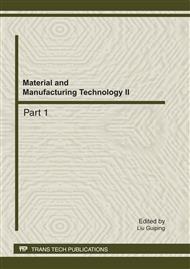[1]
M. Haruta, Catal. Today, 36 (1997) 153-166.
Google Scholar
[2]
M. Haruta, M. Date, Appl Catal A Gen, 222 (2001) 427-437.
Google Scholar
[3]
F. Boccuzzi, A. Chiorino, M. Manzoli, P. Lu, T. Akita, S. Ichikawa, M. Haruta, J. Catal., 202 (2001) 256-267.
DOI: 10.1006/jcat.2001.3290
Google Scholar
[4]
W. An, Y. Pei, X.C. Zeng, Nano Lett., 8 (2008) 195-202.
Google Scholar
[5]
G.C. Bond, D.T. Thompson, Catal. Rev. Sci. Eng, 41 (1999) 319-388.
Google Scholar
[6]
R.J. Davis, Science, 301 (2003) 926-927.
Google Scholar
[7]
D. Andreeva, V. Idakiev, T. Tabakova, L. Ilieva, P. Falaras, A. Bourlinos, A. Travlos, Catal. Today, 72 (2002) 51-57.
DOI: 10.1016/s0920-5861(01)00477-1
Google Scholar
[8]
F. Boccuzzi, A. Chiorino, M. Manzoli, D. Andreeva, T. Tabakova, J. Catal., 188 (1999) 176-185.
Google Scholar
[9]
Q. Fu, H. Saltsburg, M. Flytzani-Stephanopoulos, Science, 301 (2003) 935-938.
Google Scholar
[10]
R.J.H. Grisel, B.E. Nieuwenhuys, J. Catal., 199 (2001) 48-59.
Google Scholar
[11]
G.C. Bond, D.T. Thompson, Gold Bulletin, 33 (2000) 41-51.
Google Scholar
[12]
A.S.K. Hashmi, G.J. Hutchings, Angew. Chem. Int. Ed., 45 (2006) 7896-7936.
Google Scholar
[13]
M. Valden, X. Lai, D.W. Goodman, Science, 281 (1998) 1647-1650.
Google Scholar
[14]
P.J. Feibelman, D.R. Hamann, Phys. Rev. Lett., 52 (1984) 61-64.
Google Scholar
[15]
L.Y. Gan, Y.X. Zhang, Y.J. Zhao, Journal of Physical Chemistry C, 114(2010) 996-1003.
Google Scholar
[16]
C. Majumder, S.K. Kulshreshtha, Phys. Rev. B., 73 (2006) 155427-155421.
Google Scholar
[17]
B. Delley, J. Chem. Phys., 92 (1990) 508-513.
Google Scholar
[18]
B. Delley, J. Chem. Phys., 113 (2000) 7756-7764.
Google Scholar
[19]
J.P. Perdew , Y. Wang, Phys. Rev. B, 45 (1992) 13244-13249.
Google Scholar
[20]
C.D.R. Lide, Handbook of Chemistry and Physics, CRC Press, Boca Raton, FL, (1995).
Google Scholar
[21]
T.K.J. a. Pettiette-Hall.C. L, J. Chem. Phys., 96 (1992) 3319-3329.
Google Scholar
[22]
E.K. Ho, W.J. Lingerger, Chem. Phys., 93 (1990) 6987-7002.
Google Scholar
[23]
C.E. Moore, Atomic Energy Levels. Ed. Washington, DC, (1958).
Google Scholar
[24]
Cheeseman M.A., Eyler J.R., J. Phys. Chem., 96 (1992) 1082-1087.
Google Scholar
[25]
A. Deka, R.C. Deka, J. Mol. Struc-Theochem, 870 (2008) 83-93.
Google Scholar


